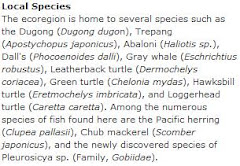Size: An adult Red Knot is 23-26 cm long with a 47-53 cm wingspan.
Breeding: The female lays 3 to 4 eggs in a shallow scrape lined with leaves and moss Both parents incubate the eggs, but the female leaves before the young fledge.
Migration: After reproduction, they move south (Australia).
Physical description: It has short dark legs and a medium thin dark bill. The body is mottled grey on top with a cinnamon face, throat and breast and light-coloured rear belly. In winter the plumage becomes uniformly pale grey.
Diet: Knots eat mostly spiders, arthropods and larve obtained by surface pecking, and on the wintering grounds they eat a variety of hard-shelled prey such as bivalves, gastropods and small crabs.
Size: It is maximum 9 in (~23 cm) in length.
Diet: It eats plankton and fish larvae.
Predator: Fish, mammals, birds, sharks, etc...
Physical description: The anchovy is a small green fish with blue reflections due to a silver stripe that runs from the base of the caudal fin. It has sharp teeth in both jaws.
Diet: Fish and Cephalopods. Shoals of fish such as herring, anchovies and mackerel are common meals.
Physical description: " It has a very thick body and a small head. The colouration is rather like that of an Orca— the main body of the porpoise is very dark grey to black with very demarcated white patches on the flank that begin some way behind the flippers, which are small and close to the head. The dorsal fin is set just back from the middle of the back and sits up erect. The upper part of the dorsal fin has a white to light grey "frosting". The fluke has a similar frosting. The adult fluke curves back towards the body of the animal, which is another distinguishing feature."
Mud Snail (Nassarius antipodarum)
Size: can be up to 12 mm(o.5in) long but the average size is 5 mm (0.2 in).
Diet: Mud snails feed on decomposing animal and plant matter, bacteria, and algae.
Predators: Shore birds and many different species of fish.
Physical description: This is an operculate snail, meaning it has a 'lid' that can seal the opening of its shell.
The shell can be either gray or brown in colour, and typically has five to eight 'whorls' coiling out in a clockwise ('right handed') direction.
Breeding: They can reproduce asexually; females "are born with developing embryos in their reproductive system." Each female can produce between 20 and 120 embryos.



No comments:
Post a Comment